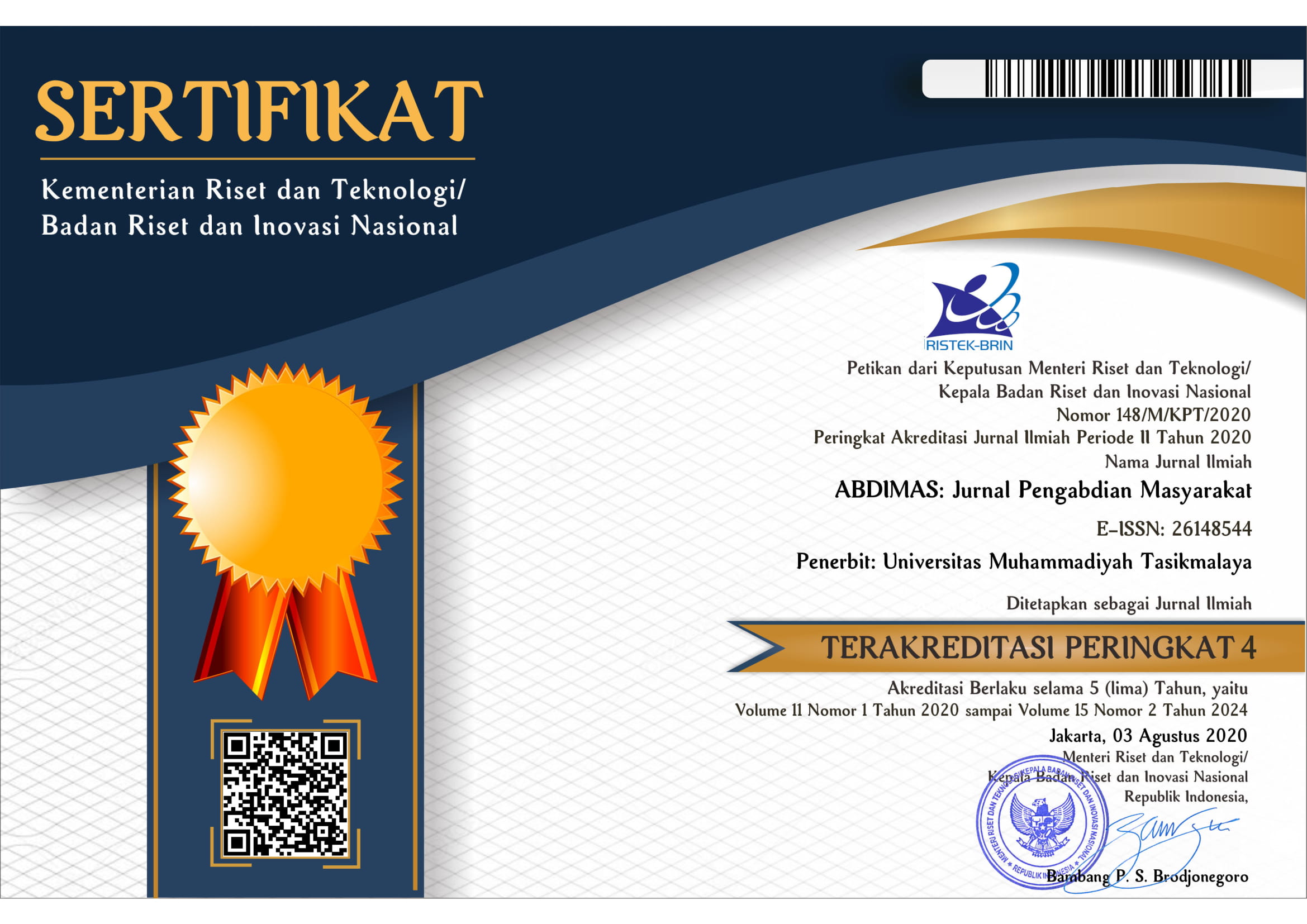Improving the Quality of Honey and Socialitzion of Flora Nectar Producer as Bee Feed in the Bangunkarya Village Langkaplancar District Pangandaran
DOI:
https://doi.org/10.35568/abdimas.v6i4.4025Keywords:
Aspiring Geopark, nectar potential, quality, honey productionAbstract
Honey production depends on the availability of nectar and pollen as bee food. In Bangunkarya Village, this potential is abundant and has not been utilized optimally, which includes yards, gardens, and forest flora. At least fifteen residents have coffee plantations that have started to bear fruit and harvest; these people's coffee plantations are an essential source of nectar and pollen. Currently, only two residents are active in the honey business. The village in Langkaplancar District is currently active in becoming a Tourism Village in support of the Aspiring Geopark Pangandaran. Increasing the quality and production of honey is targeted in community service activities to contribute to advancing geo products. Activities include identifying nectar and pollen-producing flora, socializing nectar-producing flora, educating about hygienic honey products, and making attractive honey packaging. Two types of honey that have been improved in quality and given names to marketers are the name Hani Kuya, given to natural honey from Apis dorsata bees, and Rosisdin Honey for livestock honey from Teuwul bees (Heterotrigona sp.). Quality improvements include improving packaging, filtering techniques, dosage, and providing product name labels. Honey products that have experienced improvements in quality have been exhibited in Forum Group Discussion (FGD) activities at the Pangandaran Tourism office as a promotional step to encourage increased sales and economic value.
Downloads
References
Antoni, H. W., Ratnasari, D., Wati, M. N., & Santoso, A. M. (n.d.). Inventory of Arecaceae in Irenggolo Waterfall Kediri Seminar Nasional XI Pendidikan Biologi FKIP UNS. 344–348https://jurnal.uns.ac.id/prosbi/article/view/7750/6916.
Nadira Irwan, Abdul Kadir Kamaluddin, Asiah Salatalohy, Siti Nurjannah. (2023). Inventarisasi Tumbuhan Sumber Pakan Lebah Madu Apis mellifera di Desa Idam Dehe Kecamatan Jailolo, Kabupaten Halmahera Barat https://e-journal.unkhair.ac.id/index.php/foris/article/view/43
Fathul Yusro, Yeni Mariani, and Hikma Yanti1 (2023). "An Introduction to the Local Plants as Source of Essential Oils for The ...." 31 Jul. 2023, https://www.journal.umtas.ac.id/index.php/ABDIMAS/article/view/3608.
Lima, D. De, Lamerkabel, J. S. A., & Welerubun, I. (2019)."Identifikasi Tumbuhan Penghasil Polen dari Madu Lebah Tanpa Sengat di Belitung: Identification of Plants as Pollen Source in Honey of Stingless Bee Heterotrigona itama and Tetragonula laeviceps from Belitung." 31 Jul. 2021, https://journal.ipb.ac.id/index.php/sumberdayahayati/article/view/34466.
Nila Wijayanti, Ade Mariyam Oklima, Siti Nurwahidah, Heri Kusnayadi (2022) "Karakteristik vegetasi penyusun habitat Lebah Madu Hutan (Apis dorsata ). Journal of Global Sustainable Agriculture, 3(1): 14-18, Desember 2022..." 23 Feb. 2021, https://jurnal.um-palembang.ac.id/JGSA/article/view/5291/3252
Nicolson, S. W., & Nicolson, S. W. (2022). Sweet solutions : nectar chemistry and quality."Sweet solutions: nectar chemistry and quality | Philosophical ...." 02 May. 2022, https://royalsocietypublishing.org/doi/10.1098/rstb.2021.0163.
Priyambodo, P., Lestari, E., Permatasari, N., Sidik, M., & Ayu, I. (2023). Optimizing honey production in stingless bee farming. 4(2), 360–367 https://www.researchgate.net/publication/372092236_Optimizing_honey_production_in_stingless_bee_farming/fulltext/64a4238ac41fb852dd4db6d0/Optimizing-honey-production-in-stingless-bee-farming.pdf.
Purnamasari, D. K., Resti, R., & Muhsinin, M. (2022). Identifikasi Jenis Tanaman Pakan Lebah Madu sebagai Sumber Nektar dan Polen. 13(2), 206–220. http://jurnal.polbangtanmanokwari.ac.id/index.php/jt/article/view/254.
Utami, S., Sulistyarsi, A., Taufiq, A. R., & Kusuma, Y. A. (2022). Improving Marketing strategies of An-Nahl Honey Bee Farm Products through E-Commerce Marketing on An-Nahl’s Website. 8(2), 107–112. https://jurnal.ugm.ac.id/jpkm/article/view/61151.
Supeno, B. (2021). Enhances production of coffee ( Coffea robusta ): The role of pollinator, forages potency, and honey production from Tetragonula sp . ( Meliponinae ) in Central Lombok, Indonesia. 22(10), 4687–4693.https://www.smujo.id/biodiv/article/view/9439.
Zarni, W., Afida, M. N., & Tengah, A. (2022). "Struktur Komunita Jenis Tumbuhan Famili Arecaceae Di Kebun Kopi Di Desa Toweren Antara, Kabupaten Aceh Tengah. “https://jurnal.ar-raniry.ac.id/index.php/PBiotik/article/download/14232/7480.
Zhang, Y., Xiong, Y., & Liu, Y. (2021). Pollen morphological analysis of papaya ( Carica papaya L .). 25 Oct. 2021, https://www.scielo.br/j/cbab/a/R99d7ZwhMXypRMGwsHWk4BM/.














